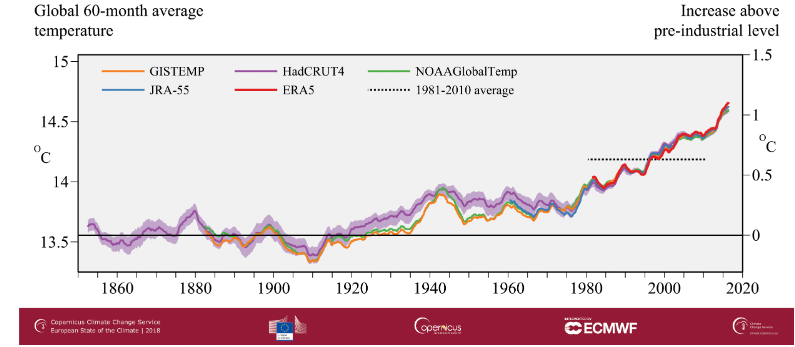Understanding the Pre-Industrial Baseline and Its Importance
Written on
The Significance of the Pre-Industrial Temperature Baseline
Consider this: if I told you that the temperature on Pluto is currently -220°C, you might think that’s freezing and would need warm clothing. However, you’d actually be mistaken. For Pluto, -220°C is comparable to a pleasant summer day. This highlights the importance of context and reference points, as baseline temperatures play a crucial role in climatology.
On Earth, scientists are meticulously working in laboratories worldwide to establish a reference point to measure climate change. This reference is vital for understanding our impact on the planet and its climate, particularly as responsible caretakers—albeit not the best ones.
If our primary concern is humanity’s effect on the climate, we would compare today's temperatures with historical planetary temperatures. However, without a device that allows time travel to an era when humans were primitive, this task becomes challenging. Instead, scientists must utilize complex models, ice core data, and intrinsic factors like El Niño alongside extrinsic elements such as solar activity to create a comprehensive understanding of global climate devoid of human influence.
But is our main concern truly humanity’s impact, or is it the rapid change in climate itself? If we are focused on a warming world, the significant factor is the temperature difference between now and the time before human impact began.
Both aspects are indeed important. Questions about the rate and extent of climate change, as well as humanity's role, are critical. For instance, if natural cycles suggest the Earth should be cooling but it continues to warm, it emphasizes the impact of human activity.
The Intergovernmental Panel on Climate Change (IPCC) serves as the leading international authority on climate change assessment. Their evaluations inform governmental policies on climate. They utilize the pre-industrial global temperature as a benchmark and label any deviation from it as an anomaly. In many visual representations, this reference point is marked as ‘0’, with any changes shown as positive or negative values.
For the IPCC, the pre-industrial baseline refers to the average global temperature prior to the Industrial Revolution, specifically from 1850 to 1900—a timeframe that marks the beginning of significant human-induced climate change.
However, it is noteworthy that scientists do not unanimously agree on the exact definition of pre-industrial temperatures. While some advocate for the 1850-1900 period, others prefer 1870-1900. This choice of baseline can lead to substantial differences in estimates of warming attributable to industrialization.
When determining a baseline, it is crucial to use an average over several years to reduce the impact of natural climate variations. Why was 1850-1900 selected? This period precedes major human-induced climate changes, and quasi-global weather records started around this time. By the mid-1800s, weather services were established, recording a variety of atmospheric data. This led to the beginning of the longest continuous instrumental climate record.
Despite the onset of human-induced climate impacts in the 1700s, reliable global temperature data from that time is lacking. Indirect measurements suggest that global warming from the early 1700s to 1850 was only about 0.1°C. During the period from 1750 to 1850, atmospheric CO₂ levels rose significantly, underscoring the rapid pace of change we witness today.
The 1850-1900 period is considered the first sufficiently comprehensive timeframe for global temperature observations. Previous IPCC reports utilized 1750 as a reference point, but later assessments moved to the 1850-1900 average for consistency and clarity in reporting.

The IPCC does not cite a single value for the pre-industrial temperature because their reports synthesize data from various studies, each employing different methodologies. The following graph illustrates global temperatures according to different datasets since 1850.

Despite variations in data sources, it is clear that the average global temperature from 2014 to 2018 was the highest on record. Since the pre-industrial era, warming is estimated at about 1.1°C, with an average increase of 0.1°C every five to six years since the mid-1970s. However, this rate of warming has not been uniform; for instance, the years from 2003 to 2012 showed little change, followed by a sharp increase from 2015 to 2018, which were the warmest years recorded.
It's essential to acknowledge that climate change does not occur uniformly across the planet, necessitating regional pre-industrial reference points. For example, Europe’s average temperature has risen nearly 2°C since the late 19th century, significantly outpacing global averages.
The IPCC has concluded that it is highly likely that human activity is the primary driver of warming since the mid-20th century and that the climate will likely continue to warm even with emission reduction efforts. The choice of pre-industrial reference period can influence historical warming estimates, but consistent definitions do not alter our understanding of human impact on climate change.
Chapter 2: The Role of Soil Carbon in Climate Dynamics
In the video titled "The Soil Carbon Code: Science behind Agricultural Emissions with Yard Stick's Chris Tolles," viewers will gain insights into how soil carbon levels affect agricultural emissions and climate change.
The second video, "Chris Tolles of Yard Stick - measuring soil carbon accurately, instantly, and affordably," delves into innovative methods for measuring soil carbon, crucial for understanding its role in climate change.